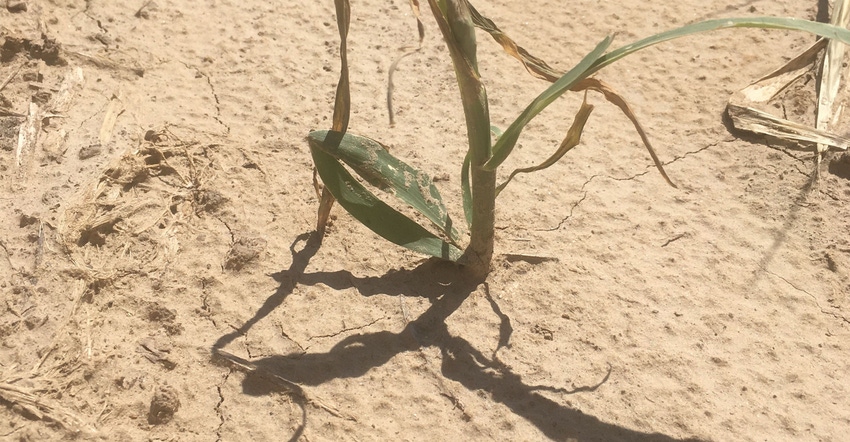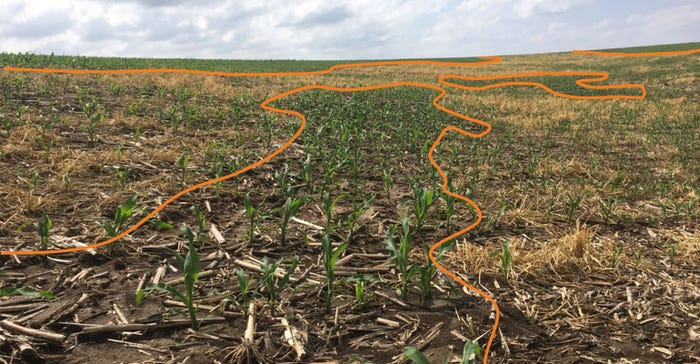
With the increased use of cover crops in Nebraska, concerns are rising over insect pests harboring in covers that could cause problems for subsequent cash crops.
For all of the benefits of cover crops, including reducing soil erosion, increasing soil organic matter, suppressing weeds, and conserving nitrogen and other nutrients, the pest concerns are real.
In 2017, wheat stem maggot was found damaging early-season corn planted into wheat or rye cover crops in central and eastern parts of Nebraska. Corn plants were showing dead heart syndrome and excessive tillering.
In each of the cases, corn had been planted directly into a living cover crop before the cover had been terminated, with termination occurring one to 13 days after planting. In some cases, where only small portions of a field had been planted into a cover for erosion control, damaged corn plants from WSM were confined to within a few feet of where the cover crop had been growing during planting time.
 TO THE ROW: Orange lines drawn delineate damaged areas in a field where corn was planted directly into growing cover crops before termination. The corn was damaged by WSM that had moved from the cover crop after termination into the subsequent corn.
TO THE ROW: Orange lines drawn delineate damaged areas in a field where corn was planted directly into growing cover crops before termination. The corn was damaged by WSM that had moved from the cover crop after termination into the subsequent corn.

“The range of percentage of plants showing symptoms was from 1% to 5% all the way to 50% to 60%, with some growers reporting 30-bushel-per-acre yield losses in fields with a high number of infested plants,” says Justin McMechan, Nebraska Extension crop protection and cropping systems specialist. “Most of the fields we sampled were in the southern portions of the state, with one field in the north-central section.” McMechan says that this is not a new circumstance, but something that has been reported in isolated fields in 2005 and 2015 in Nebraska.
Larvae stage feeding
Field observations from affected fields showed that WSM-damaged plants were almost to the row where a cover crop was still growing when the corn was planted. McMechan thinks that the maggots were in the larvae stage feeding on the cover crop when it was terminated with herbicide. The maggots simply moved from the terminated cover into the corn to complete their development.
“Some growers were concerned about adult WSM laying eggs, but we’ve caged adult WSMs on corn plants and haven’t seen any complete development nor have they caused any damage to corn plants,” he notes. “Controlled studies don’t always reflect real-world conditions, so I’m not going to rule it out yet.”
McMechan says that growers should plan to terminate their cover crop early to prevent this issue in areas where they’ve had problems. “I know this is a contrast to the goal of cover crops to produce large amounts of biomass and growth,” he says. “This practice collides with the need to plant corn early to get high yields. But how do I handle this risk of WSM?”
He says that last year, there may have been circumstances that helped WSM that do not exist every year. “We’ve set up studies for this spring to track WSM adults, and observe if they are present prior to cover crop termination in the spring,” McMechan says. “We’re also testing different grass hosts to check their susceptibility to WSM.”
McMechan does not recommend automatically spraying insecticides when terminating a cover crop. “First, we don’t know when WSM will leave the cover crop after a spray application,” he says. “There may be no residual left by the time they move to corn. Also, if we start spraying, we are also going to take out all of the beneficial insects.”
Several studies have been conducted on insects in cover crops; however, some of these are 20 or more years old, using different management practices than today’s cover crop growers. Such differences make the interpretation for risk and benefits of insects in cover crops difficult, McMechan says. Some studies have shown the potential impact of beneficial insects in cover crops.
A recent study by Lundgren and Fergen in South Dakota found that ground and rove beetles present in cover crop treatments of slender wheatgrass reduced third instar populations of western corn rootworm. “We would expect increased ground beetle activity with increased vegetation and plant diversity,” he says. “If you provide the vegetation, decomposers come in, or early pests and predators will colonize those areas for when a primary pest shows up. Being present early means that pest populations may be kept low in the crop.”
Another example is research from Robert Koch citing a reduction of soybean aphids in rye cover crop fields in five out of six years. “Predators like minute pirate bugs, syrphid flies and lady beetles respond to insect populations and appear to have kept soybean aphid numbers low in areas with cover crops,��” McMechan explains.
While there are always insect pests like black cutworm, true armyworm, green cloverworm, Japanese beetle, bean leaf beetle and stinkbugs associated with cover crop plantings, McMechan cites ground and lady beetles, hover flies and spiders as beneficials that potentially provide economic control of other pests for crops planted with cover crops.
“It’s more important than ever to scout your fields,” he says. “A large amount of research is needed to understand what insects are in our cover crops and how they impact the subsequent cash crop.”
Learn more by contacting McMechan at [email protected].
About the Author(s)
You May Also Like






